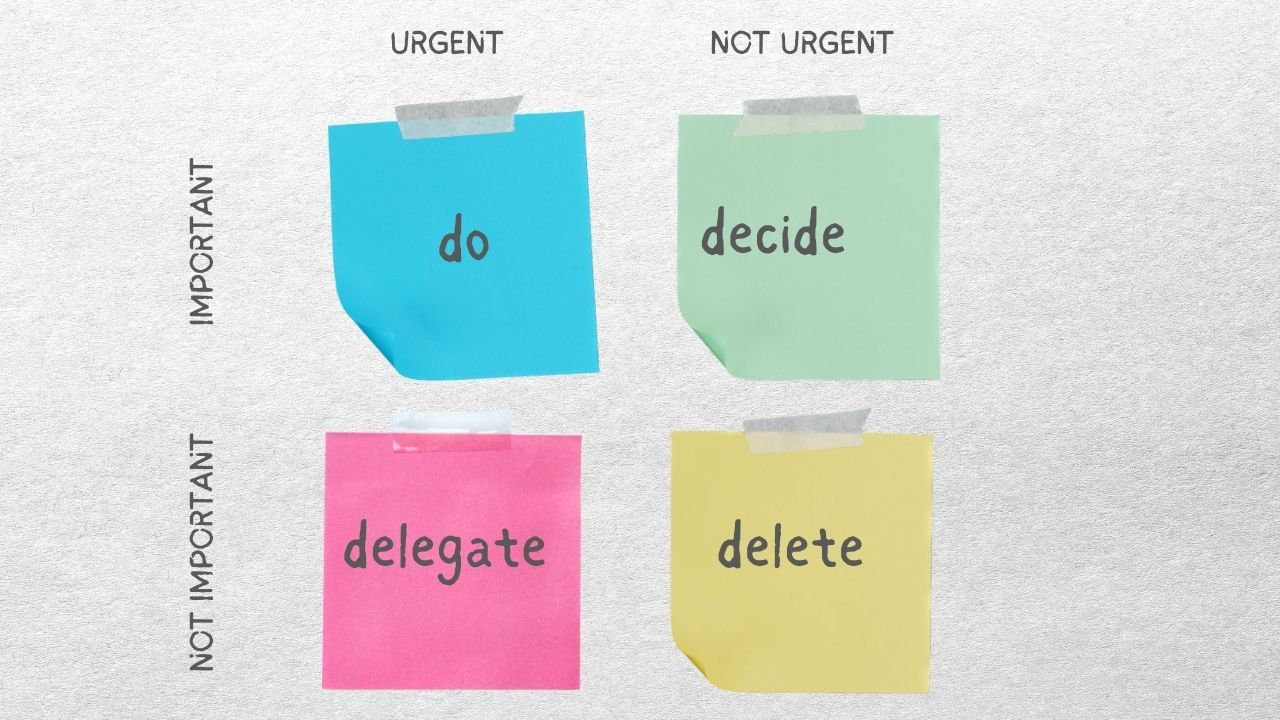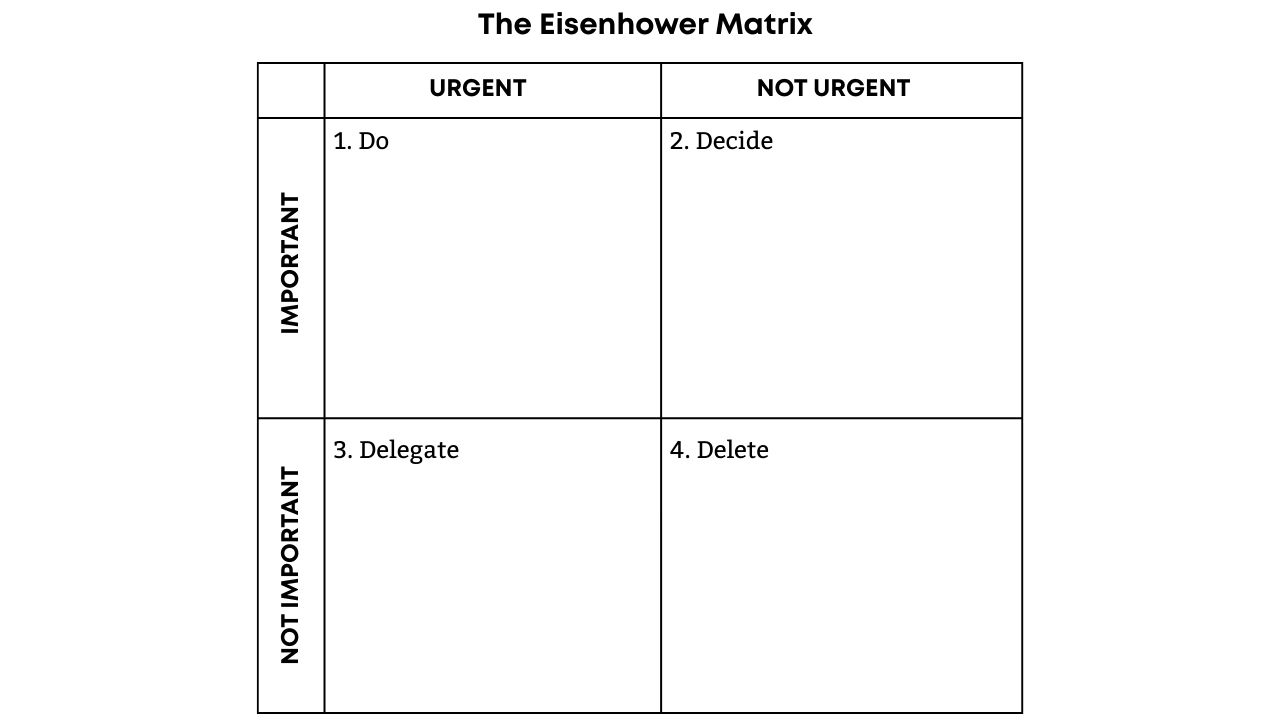Eisenhower Matrix: How to Prioritise When Everything Feels Urgent (and Important)
May 28, 2025
The Problem: You're Always Busy But Never Getting Ahead
Most small business owners are always busy. But are you actually working on the right things?
Before I had systems and processes in place, I was constantly reacting to whatever felt urgent - answering emails ("we'd like to stock your products but we can't find a wholesale form on your website?", dealing with team questions ("did you save my login?"), handling last minute issues ("we don't have any postage labels left and the courier's due in 45 mins").
My days were packed, but I never seemed to have time for the tasks that actually moved my business forward. Stuff like marketing consistently, fixing stuff properly so it wouldn't happen again, planning ahead, or working on growth strategies.
I didn’t have boundaries. My team would interrupt me all the time, and because I didn’t have a clear way to prioritise, I wasn’t delegating the right things (or enough things).
That’s one of the reasons I track my time so religiously now. I want to see exactly where my time is going so I can make sure I’m focusing on the important—not just reacting to the urgent.
If you haven't done a Time Audit yet, that's your first step - read more here.
And if you feel, like I used to, that your days are packed but you’re not making progress, it’s probably because you don’t have a clear way to decide what needs your time, what needs to be delegated, and what needs to go altogether. That’s where the Eisenhower Matrix comes in.
What is the Eisenhower Matrix?
The Eisenhower Matrix is named after Dwight D. Eisenhower, the 34th President of the United States and a former five star general. He was known for being super productive, and he once said:
"What is important is seldom urgent, and what is urgent is seldom important."
That idea - knowing the difference between what’s urgent and what’s important - became the foundation of the Eisenhower Matrix. It’s how you stop reacting to every little thing that demands your attention and instead focus on what actually makes a difference. It’s a simple (and easy) way to sort tasks based on whether they’re urgent, important, both, or neither. This helps you to make decisions strategically instead of reacting emotionally.
Or maybe you've heard this called the "Covey Time Management Matrix." Eisenhower came up with the core concept of Urgent vs. Important. But Stephen Covey took it a step further and shifted the focus.
Covey hammered home the idea that true effectiveness comes from being proactive - spending most of your time in Quadrant II (Important but Not Urgent) - more on this shortly. This is the work of planning, building systems, and preventing future crises, which is exactly why we’re using it: to move you from a reactive firefighter to a calm, strategic CEO.

(Not that kind of Matrix!)
Why Most Business Owners Struggle to Prioritise
I'm willing to bet that as a small business owner, your problem isn't that you don't work hard enough. It's that not all tasks are equal. Here's what I see all the time with clients that I work with:
- You Spend Too Much Time on Urgent Tasks:
Urgent tasks always demand attention. Emails, last minute requests, and client issues (what I call Other People's Problems) feel like they can’t wait. And often they can't - but spending all your time firefighting means you never get to the important work that actually moves your business forward.
- You Think Everything is Important:
Without a system for sorting tasks, everything feels like a priority. But some tasks actually grow your business, while others just keep you busy. And you've gotta know the difference!
- You Don’t Have a Clear System for Deciding What to Do:
Most people decide what to work on based on what feels most pressing at the time. That’s why you end up doing tasks that aren’t the best use of your time, instead of focusing on the actually important stuff.

The Four Quadrants: Prioritisation
What I love about the Eisenhower Matrix is that it's a decision making tool. For every task that ends up on your metaphorical desk, you need to assign it to one of these four boxes.
Quadrant 1:
DO (Urgent + Important) - The Firefighter Zone
These are tasks that must be done right away or the sh*t will hit the fan. They're time sensitive and business critical.
Examples:
- fixing a major client issue
- a tech failure that stops sales
- a delivery deadline.
Action: Prioritise these actions and do them now. BUT! ...
The Goal: Look at what's falling into this box and ask yourself if advance planning or better processes could move any of these to Box 2 or 3. Plan ahead, schedule the important tasks and try to keep this box as empty as possible. Aim for as few of these disruptions as possible.
Quadrant 2:
DECIDE/SCHEDULE (Important but Not Urgent) - The CEO Zone
These tasks move your business forward, but because they don’t feel urgent, they often get ignored. For maximum efficiency, the majority of your time should be spent here.
Examples: Creating systems, strategic planning, relationship building, content planning, maintenance (i.e., preventative work).
Action: Schedule a time to do these things. Block out "CEO Time" in your calendar for Q2 tasks. Then treat this time as a non negotiable appointment with your business.
The Goal: This is where all the good stuff happens. Spending time here shrinks the Q1 dramas.
Quadrant 3:
DELEGATE (Urgent but Not Important) - The Delegation Goldmine
These tasks need to be done, but not necessarily by you. They often feel urgent because they're interruptions or other people's priorities (like those emails pinging in your inbox).
Examples: Answering customer emails, invoicing, admin tasks, most interruptions, most meetings.
Action: Delegate it. Hand these over to a VA or team member with a clear process in place. This is the fastest way to free up your time.
The Goal: Challenge the feeling of urgency. If you are the fastest order picker, but you can't pick all 300 orders, your time is better spent managing the team (or working out how to speed up the processes).
Quadrant 4:
DELETE (Neither Urgent Nor Important) - The Time Waster Zone
These are tasks that don’t add real value to your business. The fastest way to get it done might just be to get rid of it entirely.
Examples: doomscrolling, unnecessary meetings, doing things the hard way instead of automating, or just because "that's the way we've always done it".
Action: Eliminate it. Be honest with yourself and just stop doing these things.
The Goal: Ask yourself: "Is this essential?" If it’s not, see ya later.

How to Use the Eisenhower Matrix in Real Life
Understanding the Eisenhower Matrix is one thing - actually using it is where people get stuck. You've got to make it part of your decision making process. Here's how you do it:
1. Connect It to Your Time Audit
If you’ve done your Time Audit, you have a list of every task you did last week. That’s your data. So here's how we turn that data into decisions.
Take the list of tasks you generated from your Time Audit. Go through it, one by one, and assign each task to one of the four quadrants. Be brutally honest.
When you've done this bit, you'll probably see an ocean of Quadrant 1, 3 and 4 tasks and a tiny island of Quadrant 2. Now you're starting to get why you constantly feel so overwhelmed. You're living in other people's urgencies.
2. Don’t Overthink It - Sort Tasks Quickly
If you spend 20 minutes trying to figure out if something is urgent or important, you’re making it waaaay to hard.
Ask yourself:
- Does this absolutely have to be done today? → If yes, it’s urgent.
- Does this actually move my business forward? → If yes, it’s important. (And I'll be that even some of these could be moved to Q3 once you've documented how to do it!)
- If it’s neither? Delete it.
- If it’s urgent but not important? Delegate it.
Simple. Set a 5 minute timer and go for it - sort those tasks fast!
3. Integrate It Into Your System
The best way to make the Eisenhower Matrix work for you is to integrate it into the way you already plan your tasks.
Digital: If you use a task manager (like ClickUp, Asana, or Trello), create four categories based on the quadrants.
Analogue: If you prefer a basic to do list, label your tasks each day: D (Do), Dec (Decide), Del (Delegate), X (Delete).
If you’re a pen and paper person, draw the matrix in a notebook at the start of each week. Make it part of your existing system, instead of an extra thing to do (habit stacking!).
4. Review & Adjust Your Priorities Weekly
Even with the best planning, things don't go to plan. So you need a quick weekly check in:
- Look at what’s in your Decide category - have you scheduled time for it?
- Are you still holding on to Delegate tasks that should be handed over?
- Are there urgent tasks that could have been avoided if you had planned better?
Spending 5-10 minutes once a week adjusting your priorities will stop you from falling back into old habits.
Common Mistakes & How to Avoid Them
Even when business owners try to use the Eisenhower Matrix, here's what I often see:
- Treating too much stuff as urgent: Just because something is time sensitive doesn’t mean it’s important (or that YOU have to do it). Pause before reacting.
- Avoiding delegation: If you’re the only one who can do everything, you’re the bottleneck. Start small - delegate one task this week.
- Filling your time with “productive” tasks: Just because you’re working doesn’t mean you’re doing the right work. Make sure your tasks are the high value tasks. Delegate the other stuff.
Final Thoughts: From Firefighter to Architect
The Eisenhower Matrix will help you prioritise and sort your to do list. But it can also help you to change the way you see yourself. Instead of being a Quadrant 1 Firefighter/Hero, constantly reacting to the next blaze, you can become a Quadrant 2 Architect, calmly designing a fireproof business.
You have the power to decide where you spend your time. Using this matrix is your declaration that you won't continue to let urgency dictate your day. You will focus on what is truly important.
Your 3 Step Action Plan
Step 1: Do a Time Audit, if you haven't already - download that here.
Step 2: Download my Eisenhower Matrix Template and sort your tasks (no email required).
Step 3: Start delegating!
Want more awesome tips on running a seriously systemised business?
Pop your details in below to get your weekly dose of awesomeness that will get you and your business running like a well oiled machine!
We don't do SPAM - the email kind or the tinned meat kind! We will never sell your information, for any reason.


